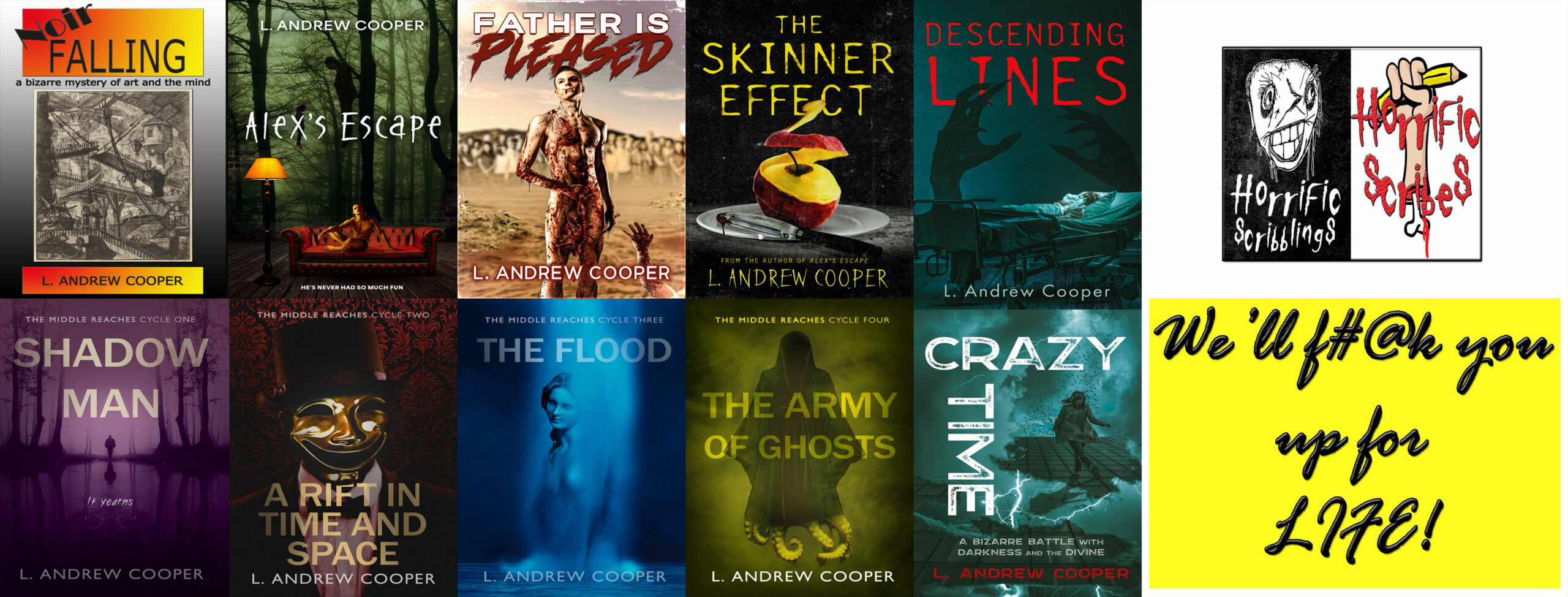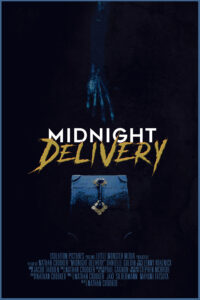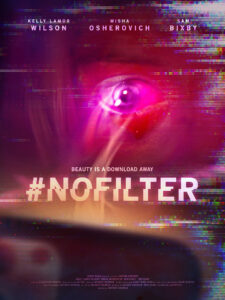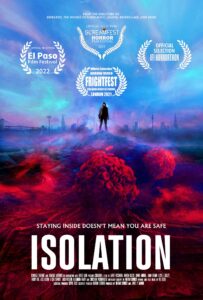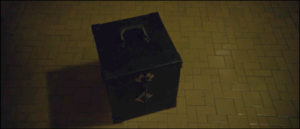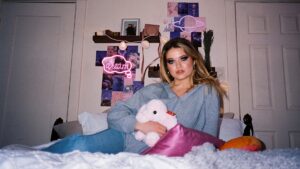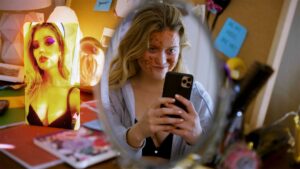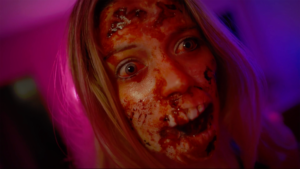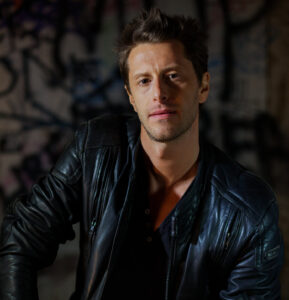Award-winning director, producer, writer, and actor Nathan Crooker knows a great deal about how to translate film into scares and about the artistic tradition of doing so. Here, he shares some of that knowledge–and some of those expert scares.
“Midnight Delivery”
Conjured from the imaginative mind behind the award-winning viral horror short “Playback,” Nathan Crooker’s latest supernatural thriller, “Midnight Delivery,” is sure to leave you second guessing that knock at your door. “Midnight Delivery” begins when a mysterious gift is delivered to an unsuspecting woman’s door at the stroke of midnight. The woman’s morbid fascination entices her to examine the gift, unleashing a sinister evil from within.
“#Nofilter”
“#Nofilter” addresses the ever-growing issues surrounding Body Dysmorphic Disorder through the eyes of Beth, an insecure twenty-something, who becomes obsessed with an insidious filter, leaving her to question true beauty. It is a cautionary tale for all those obsessed by “likes,” being flawless, and thinking that somehow social media is the magical cure-all for happiness. The film stars Kelly Lamor Wilson and Misha Osherovich from Blumhouse’s Freaky.
Isolation
Isolation is a feature-length anthology, weaving together nine tales of terror, following isolated citizens in cities around the world as they confront their darkest fears in an attempt to survive an increasingly deadly outbreak. The eleven filmmakers were only allowed to use the equipment, resources, and participants they had in lockdown. All nine scripts are original. Anthology Director Crooker created a world ten months into the future based around the current global pandemic and then briefed the filmmakers to bring their stories to life within this framework. Isolation explores the human condition through a genre lens, weaved together in an anthology experience. The films live under a banner of survival and deal with relatable themes such as human connection, paranoia, hope, love, escapism, fear of the unknown, and abandonment. Like in any good horror film, the themes transcend the genre.
The Interview
(1) Supernatural Deliveries. What’s your attraction to working with the supernatural on film? Sometimes “supernatural” is synonymous with, or at least goes hand in hand with, “unexplained.” The gift in “Midnight Delivery” and the filter in “#Nofilter” go largely unexplained—the films emphasize hard-hitting story elements other than explanation. Do you deliberately devalue explanation? If so, why?
NC: The allure of the supernatural in film, for me, has always been its innate ability to tap into the collective unconscious fears and wonders we all share. It’s a realm that transcends cultural and personal boundaries, offering a canvas on which we can explore the darkest and sometimes most enlightening facets of human experience.
Indeed, as you pointed out, the supernatural often walks hand in hand with the unexplained. And that’s part of its charm. When we’re left without an explanation, our imaginations are set free, and we become active participants in the story, piecing together our own narratives and explanations. It adds a layer of intimacy and personalization to the viewer’s experience.
Take, for instance, “Midnight Delivery” and “#Nofilter.” By not dwelling too deeply on the origins or mechanics of the supernatural elements—the gift or the filter—we can put emphasis on the characters, their emotions, and the situations they find themselves in. In essence, it’s not always about the ‘what’ or ‘how,’ but rather the ‘why’ and the emotional journey.
In many of my films, I don’t necessarily “devalue” explanation, but I often choose to prioritize emotional resonance and psychological impact over detailed exposition. Over-explaining can sometimes strip away the mystery and diminish the visceral reactions we seek in the supernatural genre.
For me, the supernatural offers a rich palette of emotions, from fear to wonder, and sometimes, the unexplained is just the right tool to paint a hauntingly unforgettable cinematic experience.
(2) Supernatural Follow-up. Your description of “Midnight Delivery” emphasizes “sinister evil,” and the film’s title sequence emphasizes “evil” as well. To what extent is evil an explanation unto itself? What does your film say about evil?
NC: “Midnight Delivery,” like many of my films, delves deep into the concept of evil, not just as a superficial force but as an underlying theme that holds a mirror up to human nature. When I emphasize “sinister evil” or use the word “evil” prominently in aspects like the title sequence, it’s to set a tone and expectation. But beneath that, I aim to provoke thought and explore deeper philosophical questions.
Is evil merely an external force that acts upon us? Or is it an inherent part of our psyche, our choices, and our circumstances? By presenting evil as both a tangible antagonist and an intangible emotion or choice, I hope to blur the lines and make viewers question where evil truly originates.
“Midnight Delivery” isn’t just a tale of confronting an external malevolent force. It’s also a journey into confronting our internal fears. Evil, in this context, becomes both the challenge and the reflection of our innermost complexities.
In essence, the film suggests that evil is multifaceted. It’s not just an external entity or a malevolent spirit; it’s also our actions, decisions, and, sometimes, inactions. By not always explicitly defining the nature or origin of evil, I aim to create a broader, more encompassing commentary on its pervasive nature in both the supernatural and human realms. Our lead actress, Danielle Guldin, expertly embodies these elements in her performance.
(3) Midnight Memories. Although “Midnight Delivery” is original, glimpses reminded me of the adaptation of Richard Matheson’s story “Prey” in Trilogy of Terror (1975). Did you think of that film (or story) when creating “Midnight Delivery?” What influences would you cite for this film? Feel free to name cinema heroes, if you have any.
NC: Ah, Trilogy of Terror – a classic! Richard Matheson’s “Prey” is undeniably one of the standout stories of horror literature and its adaptation into Trilogy of Terror left a mark on many filmmakers, myself included. While I wouldn’t say it was a direct influence on “Midnight Delivery,” it’s true that when you grow up admiring and analyzing certain films and stories, they inevitably become part of your cinematic DNA. Elements from those influences might find their way into your work, consciously or subconsciously.
A significant influence for “Midnight Delivery,” which many might find intriguing, came from a personal experience. During my travels, I had the unique opportunity to meet a shaman who presented me with a headdress. This headdress wasn’t just a beautiful artifact; it carried with it a weight of stories, mysteries, and a tangible sense of the unknown. The headdress in “Midnight Delivery” is an exact replica of that artifact. It served as a physical representation of the unseen world, a bridge between the known and the unknown.
In terms of cinema heroes, I absolutely must mention the impact of films like Texas Chainsaw Massacre and Friedkin’s The Exorcist on my cinematic journey. Tobe Hooper’s raw, gritty vision in Texas Chainsaw Massacre shattered conventions and demonstrated the power of atmospheric horror. Meanwhile, The Exorcist was a masterclass in blending profound existential themes with visceral horror, something I’ve always aspired to in my work. Filmmakers like Alfred Hitchcock, Mario Bava, John Carpenter, as well as Hooper and Friedkin, have been pillars of inspiration for me. Their works not only broke new ground but showed that horror and supernatural films can be both artistically rich and viscerally impactful. My journey with “Midnight Delivery” was about marrying my own storytelling instincts with the mosaic of influences I’ve gathered over the years, including that hauntingly beautiful headdress.
(4) Unfiltered Horror. Why did you decide to address Body Dysmorphic Disorder through a horror film? What does your film ultimately say about this disorder?
NC: In the realm of horror, one of its greatest powers lies in its capacity to viscerally embody our modern anxieties and societal pressures. With “#Nofilter”, I aimed to delve into the contemporary obsession with social media perfection and the lengths people go to for validation.
The sinister Snapchat filter in the film isn’t just a tool of horror; it’s a metaphor. For many, filters offer a brief escape, a fleeting moment where perceived flaws vanish and ideals of beauty are momentarily achieved. Our protagonist, grappling with body issues, finds solace in this digital augmentation. However, like any potent drug, the more she becomes reliant on this filter, the more she becomes ensnared, losing herself both metaphorically and literally.
As the filter begins to modify her, it’s not just about the external transformation—though the chilling process of skin-stripping visualizes the raw vulnerability many feel under societal scrutiny. It’s the internal metamorphosis, the shift in her psyche, that’s even more terrifying. The filter doesn’t just alter her looks; it erodes her identity, her very essence, until she’s absorbed into its digital realm—a stark reflection of how consuming the quest for online validation can become.
Through “#Nofilter”, I wanted to sound the alarm on the dangers of tying self-worth to digital perceptions and the harrowing lengths one might go to fit into society’s narrow definition of beauty. At its heart, the film underscores the haunting reality that sometimes the monsters we fear are birthed from our own insecurities and the digital mirrors we hold up to ourselves.
(5) Beauty and Devices. Your description of “#Nofilter” says Beth questions “true beauty.” What is the film’s vision of true beauty, and how does it relate to the film being so pretty to look at, from its actors and color palette to its well-executed effects (even when they’re gross)?
“True beauty”, as explored in “#Nofilter”, is a complex and multifaceted concept. At its core, the film seeks to deconstruct society’s narrow and often harmful perceptions of beauty, largely dictated by technology, filters, and external validations. Beth’s journey serves as a microcosm of the modern struggle with self-worth and the desire for acceptance in a world where beauty standards are both ever-shifting and unrealistically rigid.
While the film indeed boasts a visually appealing aesthetic—from the casting choices to the rich color palette and sophisticated effects—it’s all by design. The allure of the film’s ‘prettiness’ juxtaposes Beth’s internal turmoil and the sinister undertones of the narrative. This visual dichotomy between what’s on the surface and what lurks beneath is emblematic of the filters we use in real life: they present a polished, perfected exterior, often masking the raw, unfiltered realities.
The special effects, even in their grotesqueness, serve a dual purpose. Firstly, they emphasize the physical and emotional toll of seeking digital validation and perfection. And secondly, they mirror the very nature of beauty—something that can be simultaneously captivating and repelling, depending on perspective.
In essence, “#Nofilter” assumes that true beauty lies not in the filtered, altered images we present to the world but in embracing our authentic selves, flaws and all. It’s in acknowledging that these very imperfections, the raw and unfiltered aspects of our being, are what make us genuinely beautiful. The film serves as a haunting reminder that when we let external devices and platforms define our worth, we risk losing our true selves in the process.
(6) Filtered Caution. “#Nofilter” is a “cautionary tale,” and comments on Isolation mention that in “any good horror film, the themes transcend the genre.” The idea that horror has a duty to caution or otherwise edify consumers is as old as the genre. In your view, is horror for horror’s sake ever enough? Why or why not? Why are you drawn to the cautionary and transcendent?
NC: Horror, with its rich tapestry of sub-genres and narratives, possesses an innate versatility that few other genres can claim. While “#Nofilter” is a cautionary tale, weaving themes of societal expectations and the digital age’s pitfalls into its narrative, not all horror films need to possess such layered messaging.
There’s an intrinsic value in “horror for horror’s sake.” Pure, unadulterated horror can be a cathartic experience for viewers, a means of confronting and processing fears in a controlled environment. Not every horror film needs a moral lesson or profound societal commentary; sometimes, the thrill of the scare, the adrenaline rush, and the shared experience of fear are valuable in their own right.
That said, the power of horror lies in its ability to illuminate the darker corners of human existence, to take everyday fears and anxieties and amplify them to their most terrifying extremes. For me, the allure of the cautionary and the transcendent in horror stems from a desire to meld entertainment with reflection. When a horror film can not only terrify but also make viewers think, question, and discuss long after the credits roll, it achieves a longevity and impact that is truly powerful.
In essence, while horror purely for the thrill is valid and enjoyable, there’s a distinct resonance in horror films that dive deeper, challenging conventions and making audiences ponder. It’s this duality—the blend of raw emotion and thought-provoking narrative—that keeps me captivated and continually drawn to the genre.
(7) Creative Isolation. The pandemic and quarantine created a lot of fears that people shared that could fuel tales of terror. What fears and horrific images do most films in the Isolation anthology have in common, and what are a few of the most quirky or surprising?
NC: The pandemic, undoubtedly one of the most defining events of our generation, brought forth a multitude of shared anxieties. It’s these very fears that “Isolation” taps into, drawing upon the collective psyche of a world in lockdown.
A recurring theme in the anthology is the fear of the unknown—whether it’s the uncertainty of the virus itself, the unpredictability of the future, or the mysteries of our own minds when left in solitude. Another pervasive element is the juxtaposition of external confinement with internal turmoil. The films often explore the duality of being physically trapped, all while wrestling with the mental and emotional claustrophobia that such isolation breeds.
However, the anthology also revels in its diversity of interpretation and presentation. Larry Fessenden‘s segment, for instance, employs the evocative technique of stop motion, lending a surreal and haunting quality to his narrative. In a stark departure from traditional casting, Bobby Roe‘s contribution stands out, not just for its storytelling, but also for the unexpectedly profound performances of his two young children, demonstrating the depth and range young talent can bring to the screen.
The tonal range of “Isolation” is another of its striking features. While some films plunge into the abyss of darkness, embracing the gravitas of our shared situation, others adopt a more comedic approach, offering moments of levity amidst the pervasive gloom. This juxtaposition between darkness and light, terror and humor, reflects the multifaceted emotions we all grappled with during those uncertain times. The anthology, in capturing this spectrum, becomes both a chronicle of our shared experience and a showcase of the expansive canvas that is the horror genre.
(8) Productive Isolation. Your primary IMDb credit for Isolation seems to be Producer, which always has the potential to be an overwhelming job, but the mention of the title “Anthology Director” makes the job sound like it took on previously unexplored dimensions. How would you describe your work producing Isolation while in isolation?
Producing “Isolation” during these trying times was, in many ways, an exercise in both constraint and creativity. Pairing up with the immensely talented filmmaker James P. Gannon was a plus. Together, we navigated the wild challenges posed by the pandemic to craft an anthology that serves as both a reflection of the moment and a testament to the resilience and adaptability of filmmakers.
Our framework, set in a speculative future shaped by the pandemic, was a constant. However, within this canvas, our filmmakers were challenged to be both innovative and resourceful, constrained not by the imagination, but by the tangible limits the lockdown set. The strictures we imposed—eschewing the convenience of platforms like Zoom and relying only on the tools immediately at hand—were not mere obstacles. They were catalysts, pushing our directors to think outside the box and find new avenues of expression.
I distinctly recall the early days of the pandemic, watching my own feature film halt its momentum due to the encroaching virus. It was a shared sentiment, felt by countless filmmakers across the globe. Yet, it was this very moment that drove me to conceptualize Isolation. Every filmmaker involved was driven by a singular passion—to create, even when the world seemed to have stopped. Our aim was never just to tell stories, but to craft a narrative emblematic of the time, a piece that future generations would look back upon as a barometer of our collective state of mind.
Being the “Anthology Director” meant overseeing this vast tapestry of stories, ensuring each piece resonated with the overarching theme, while still retaining its unique voice. The journey, though filled with challenges, was also replete with learning moments. Once I sold the film, the process of delivering it was nothing short of Herculean. Handling this task was daunting, but it also offered a profound learning experience. In Isolation, we didn’t just produce a film—we captured a moment in history, crystallizing the trials, tribulations, and triumphs of a world in lockdown.
(9) Isolation in the Open. We’re hardly post-COVID, but at least most people are saying we’re post-pandemic. How does Isolation fit in the post-pandemic world, and where does the type of filmmaking you were helping to develop go?
In the wake of something as globally impactful as COVID, art invariably reflects the times. Isolation, even if not directly born from the pandemic, taps into that profound sense of loneliness, uncertainty, and existential angst that many experienced during those long months of confinement and separation. It’s a mirror to society’s psyche, capturing the collective emotional turbulence we all felt.
During this period, I too felt the urge to create, to put into film the myriad emotions and reflections the pandemic instilled. However, I quickly realized that penning a feature and shooting it within a mere two months wouldn’t do justice to the gravity of the times. But an epiphany struck: instead of limiting the narrative to my singular vision, why not create a world, a universe, where stories can intertwine? An anthology, brought to life by some of the most iconic and cult horror directors from around the globe. Each segment, each director’s vision, could be a mosaic piece, capturing different facets of our shared human experience during these times.
The collaborative spirit and the diverse, yet cohesive, vision paid off. Isolation wasn’t just a film; it was a testament to the unity and resilience of the global filmmaking community. Our efforts didn’t go unnoticed. We were honored to be recognized and showcased at some of the most prestigious genre film festivals, including Screamfest LA and FrightFest UK.
The pandemic magnified the human need for connection and, paradoxically, our capacity for resilience and adaptation in isolation. The stories born from this era will stand as testament to our resilience and the enduring power of cinema to reflect, challenge, and inspire. By banding together, by merging our visions, we managed to craft a piece that’s not only special but also memorable and enduring.
(10) Access! How can people learn more about you, view your films, purchase your films, and generally get access to your world (please provide any links you want to share)?
NC: If you’re into horror and all things spooky, dive into my world on Instagram @thecrooker. Additionally, you can explore my film company and my shorts at GhostGangProductions.com. If you’ve crafted any standout feature films or shorts that you believe would resonate with us, do get in touch at info@ghostgangproductions.com. For those keen on seeing the feature Isolation, it’s available for streaming on VOD and iTunes. Do check it out!
About the Filmmaker
Nathan Crooker is an accomplished filmmaker and screenwriter who hails from Leominster, Massachusetts, a small working-class town in the shadows of Boston. There he developed an interest in narrative and visual storytelling with an authentic and raw cinematic style. His career has spanned over 20 years as a professional Director, Writer, and Actor. His films have premiered at many of the top festivals, including the Sundance Film Festival, Nashville Film Festival, Nightmares Film Festival, and Popcorn Frights Film Festival. His most notable film, “Playback” went viral and acquired more than 1 million views in less than 24 hours. “Playback” was accepted in over 70 film festivals around the world and featured on countless sites such as Bloody Disgusting, Slashfilm, and Geektyrant. Crooker also produced the horror feature Before Someone Gets Hurt, starring Michael Welch from Twilight.
